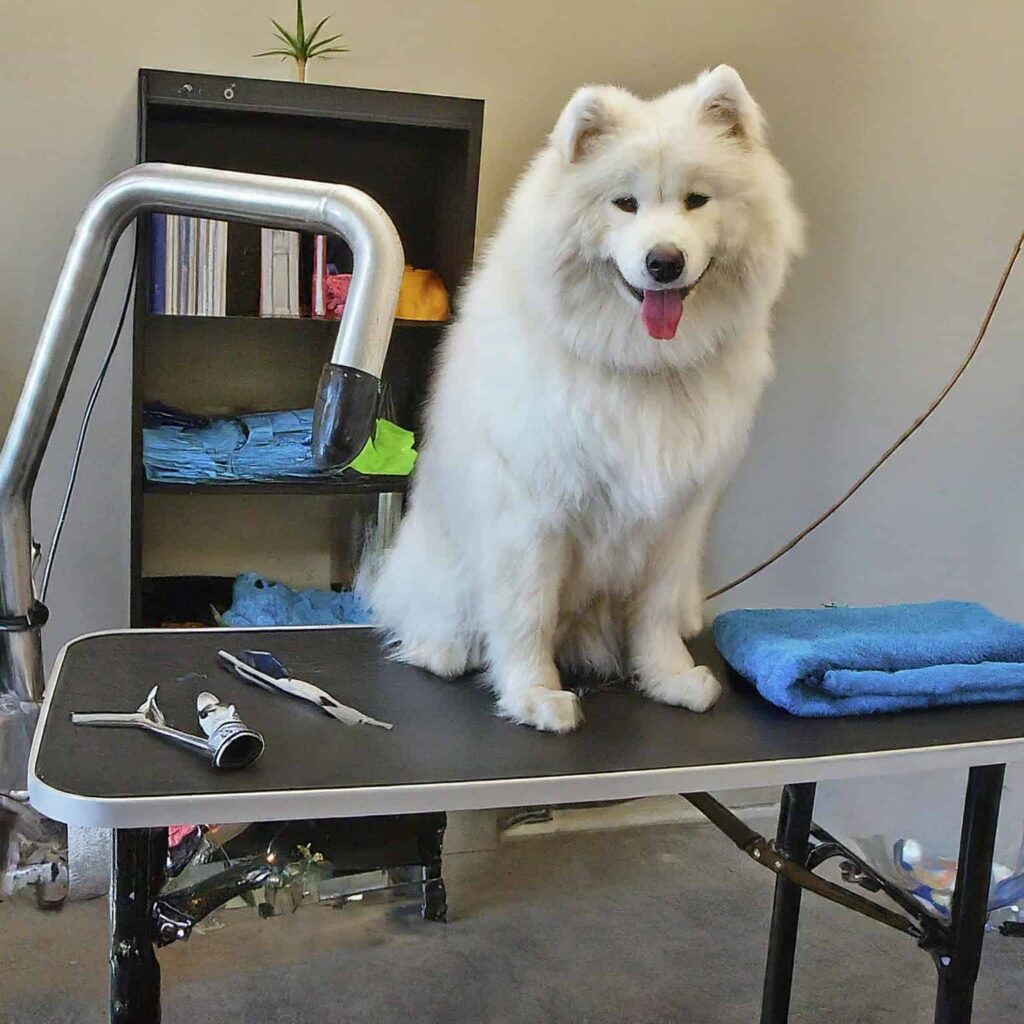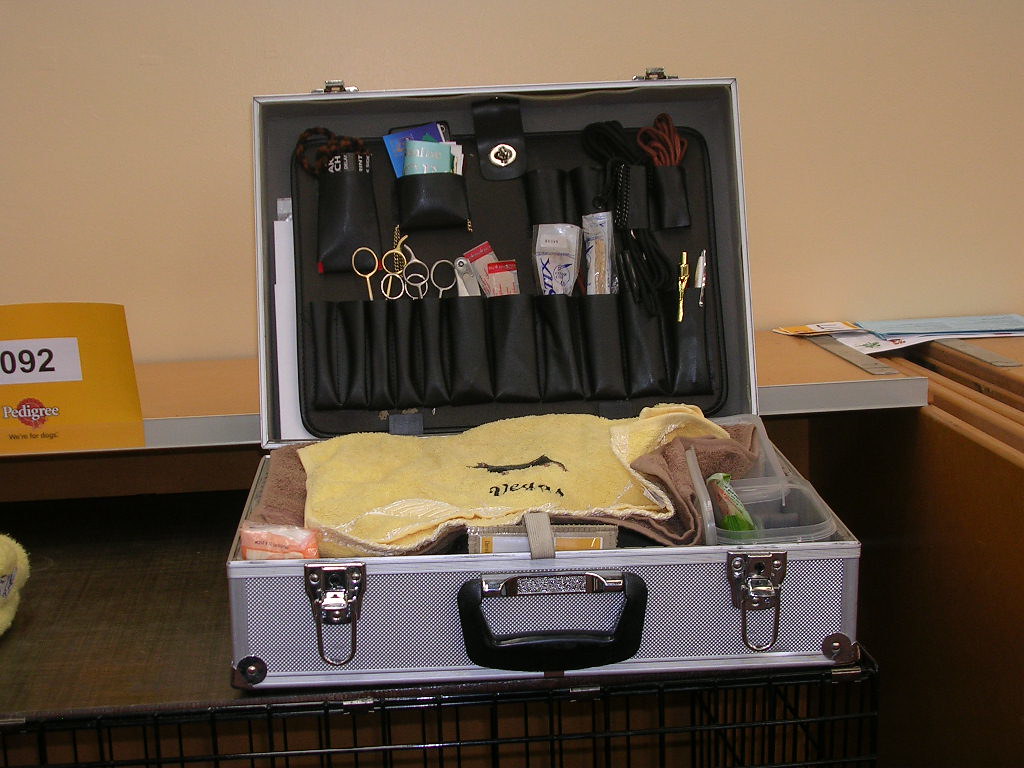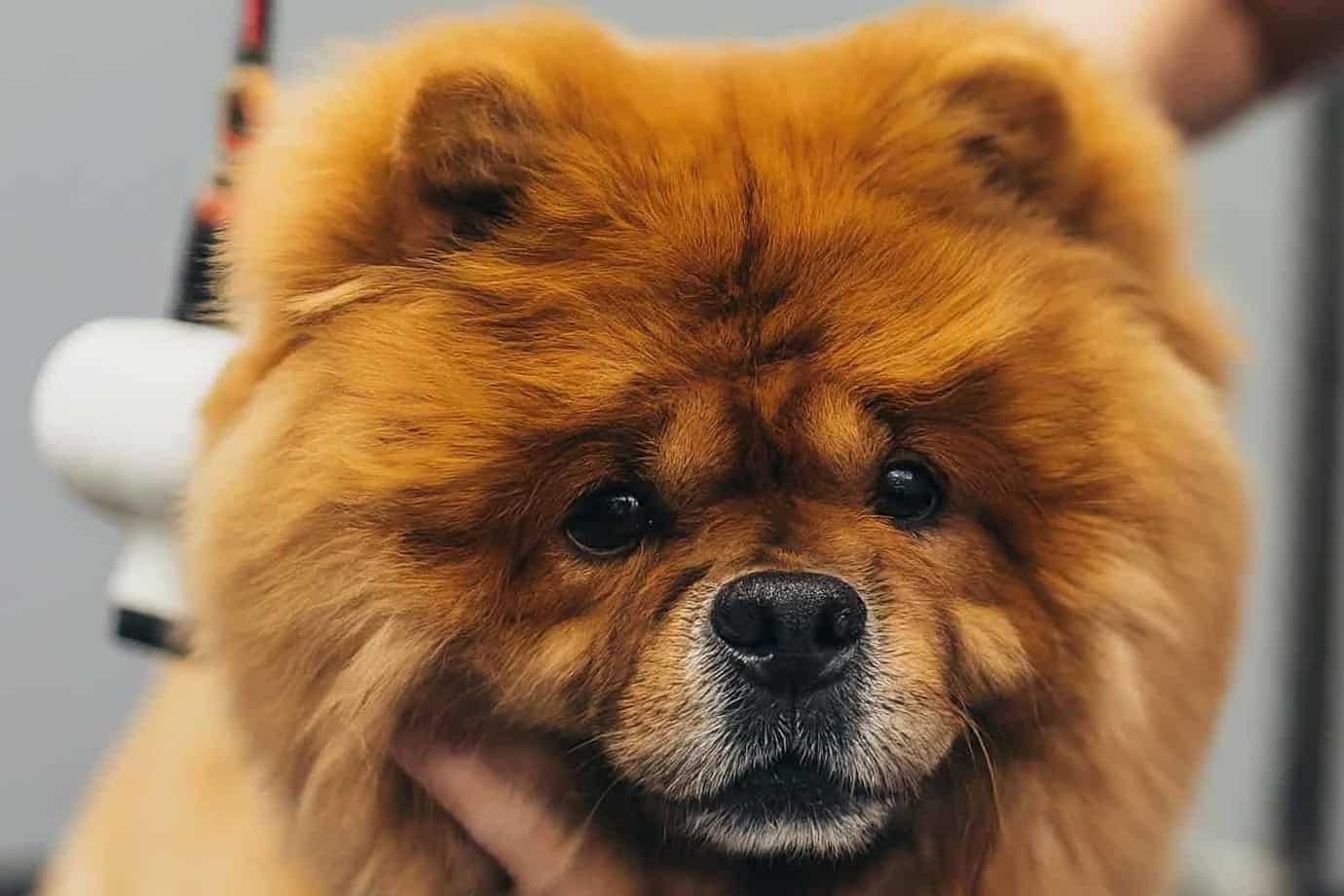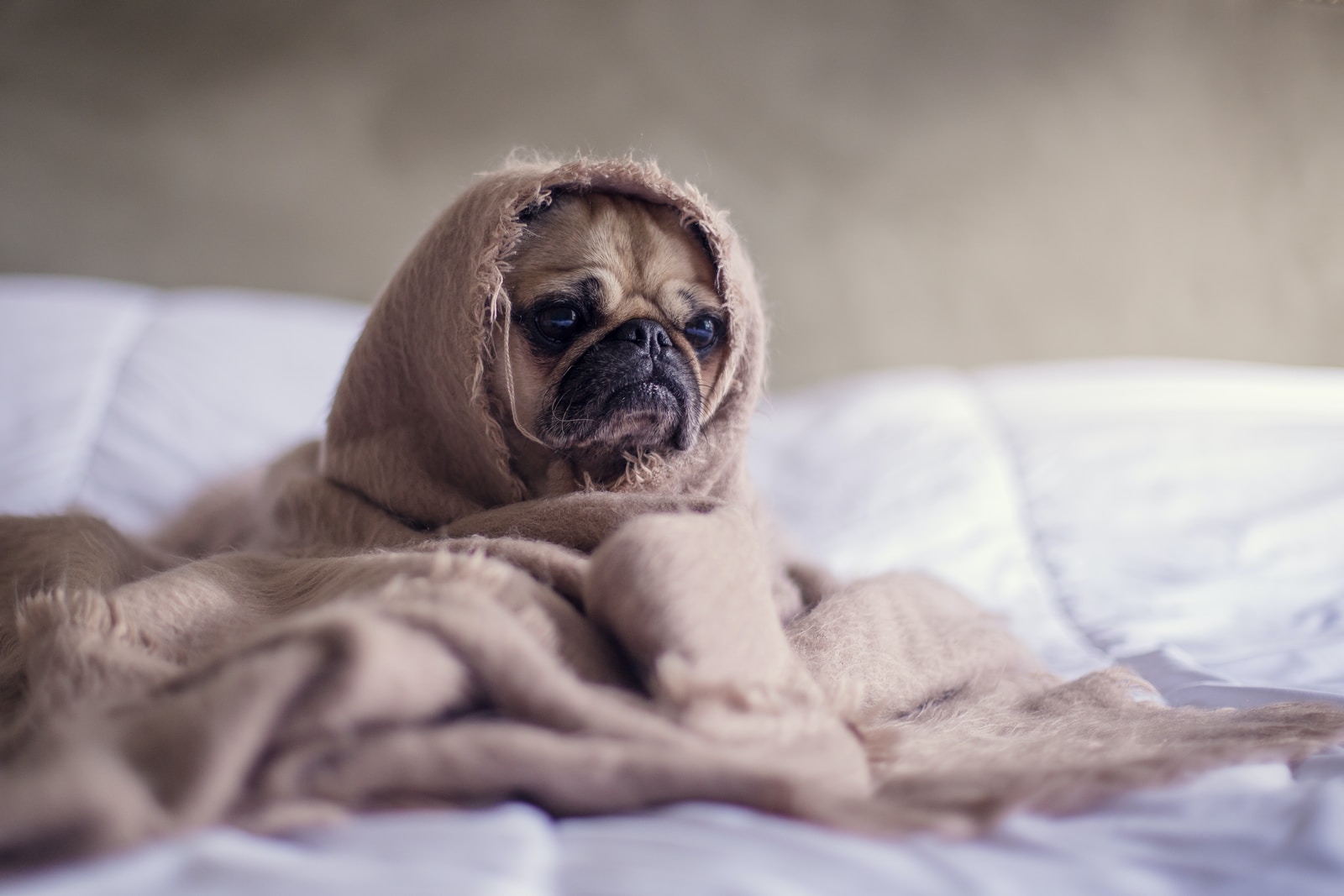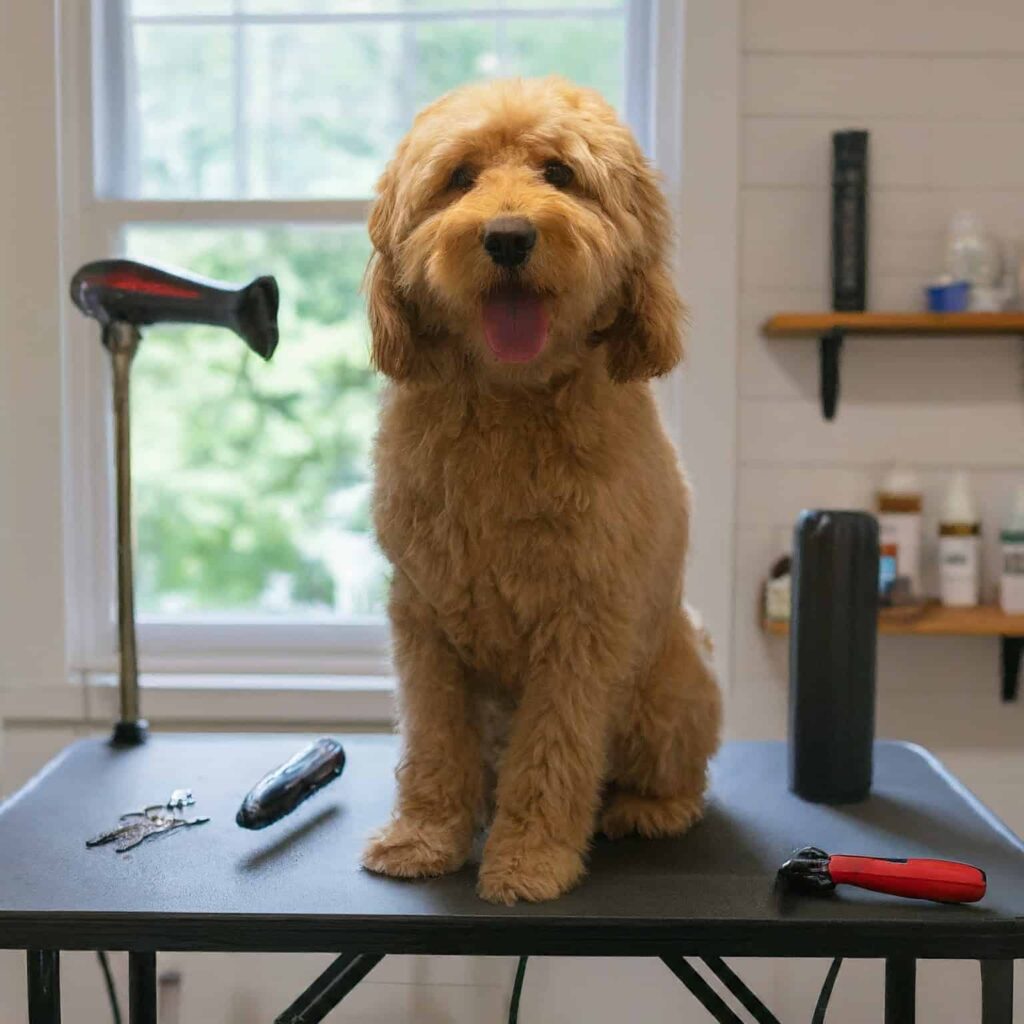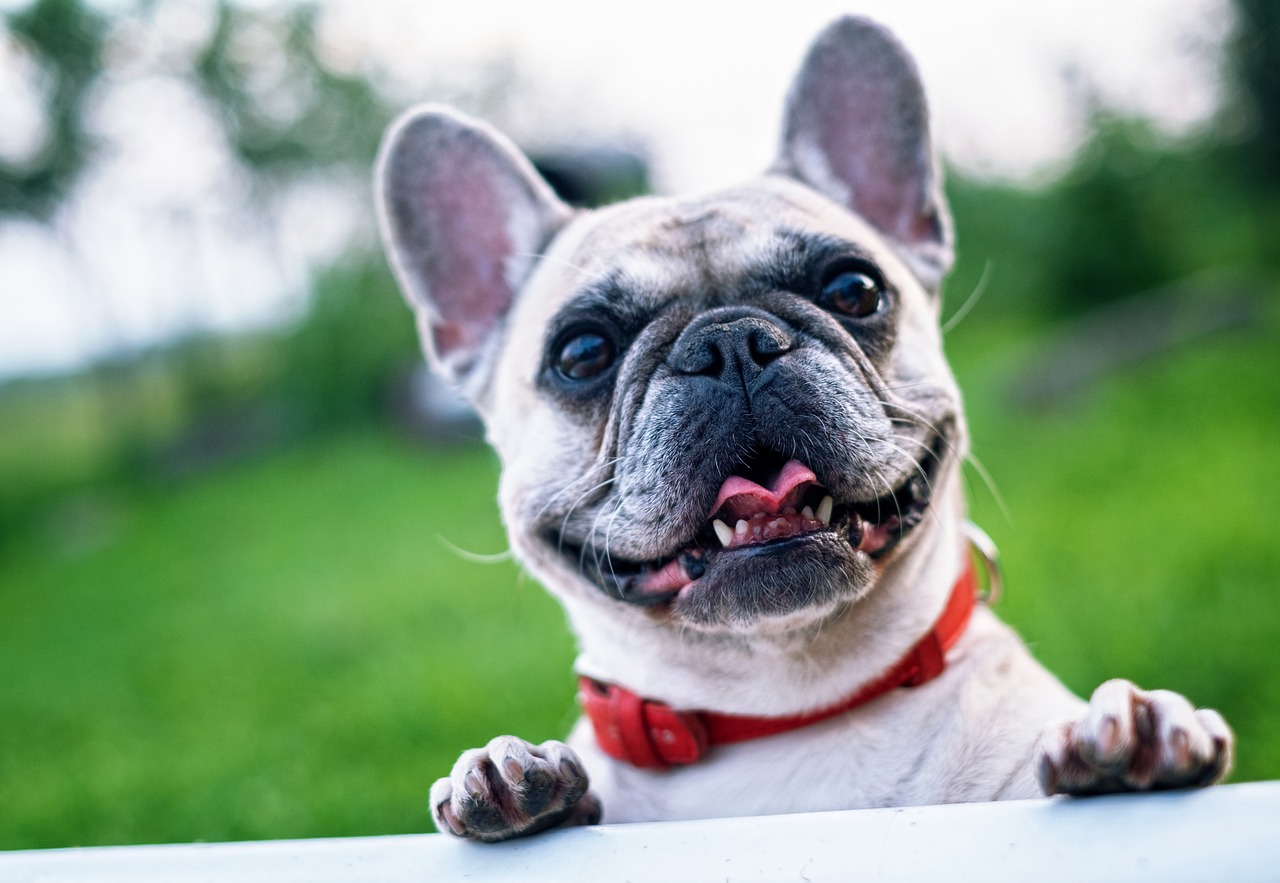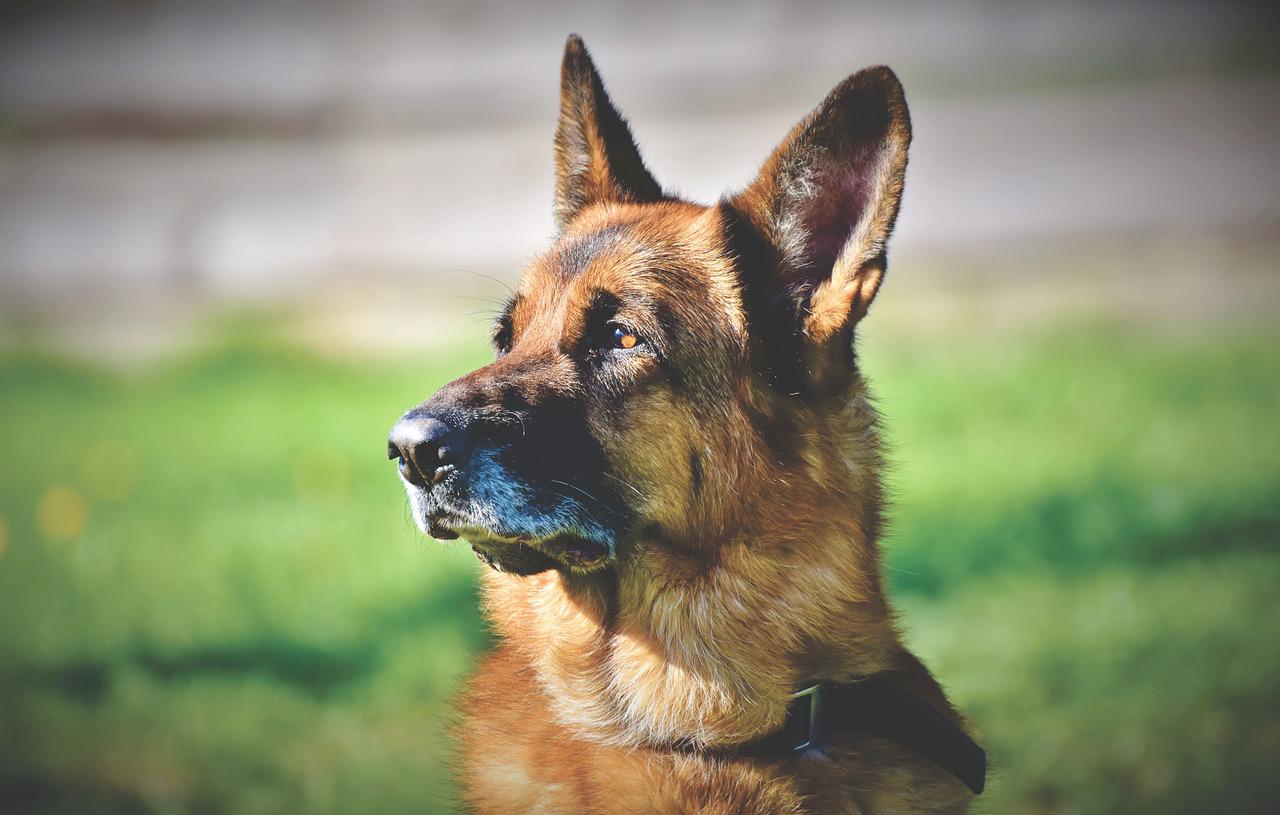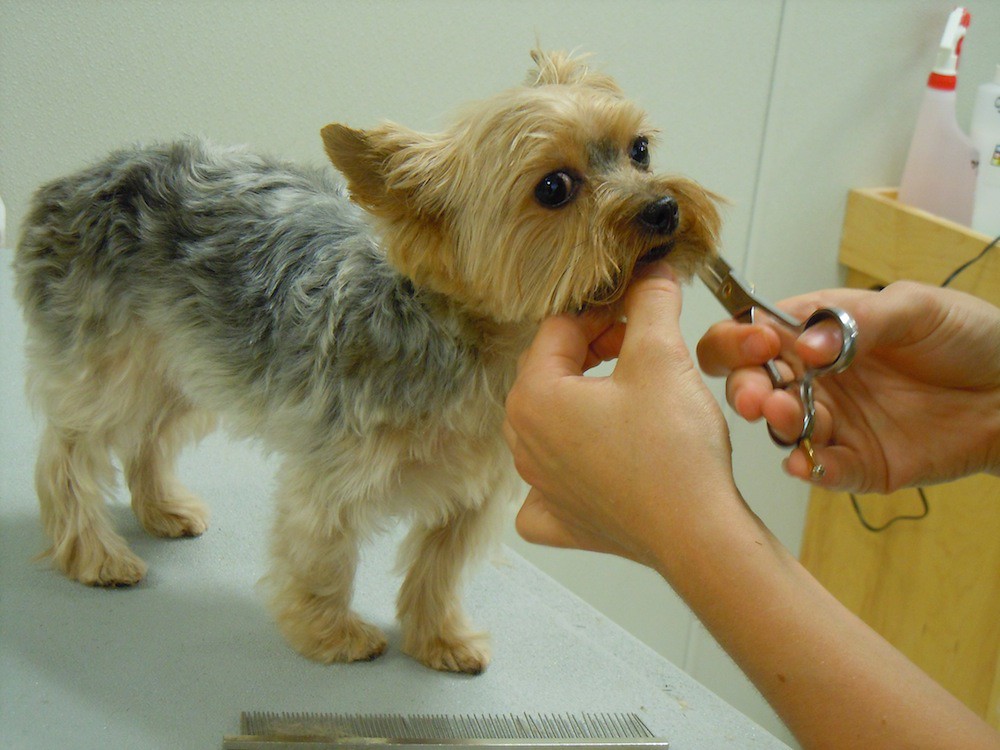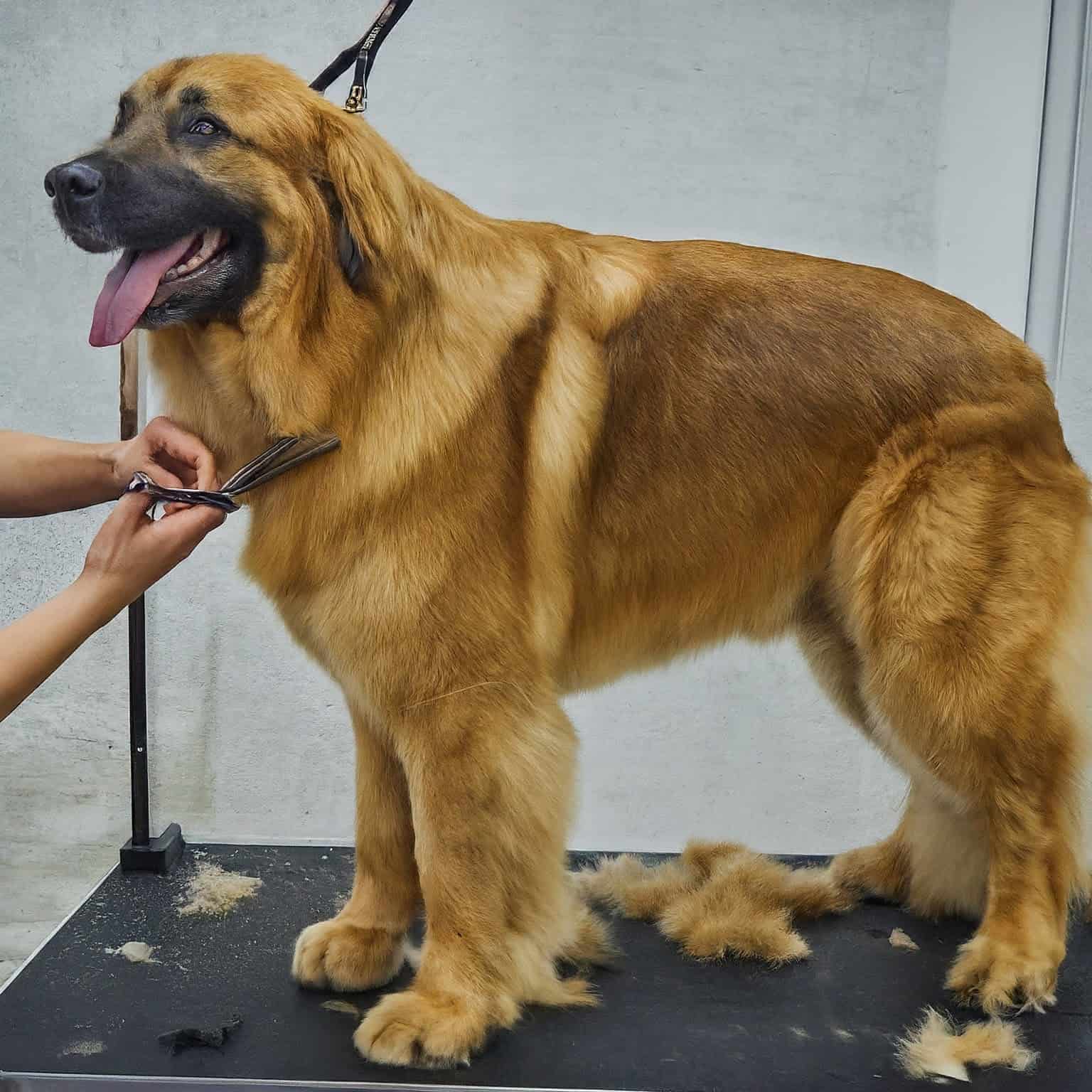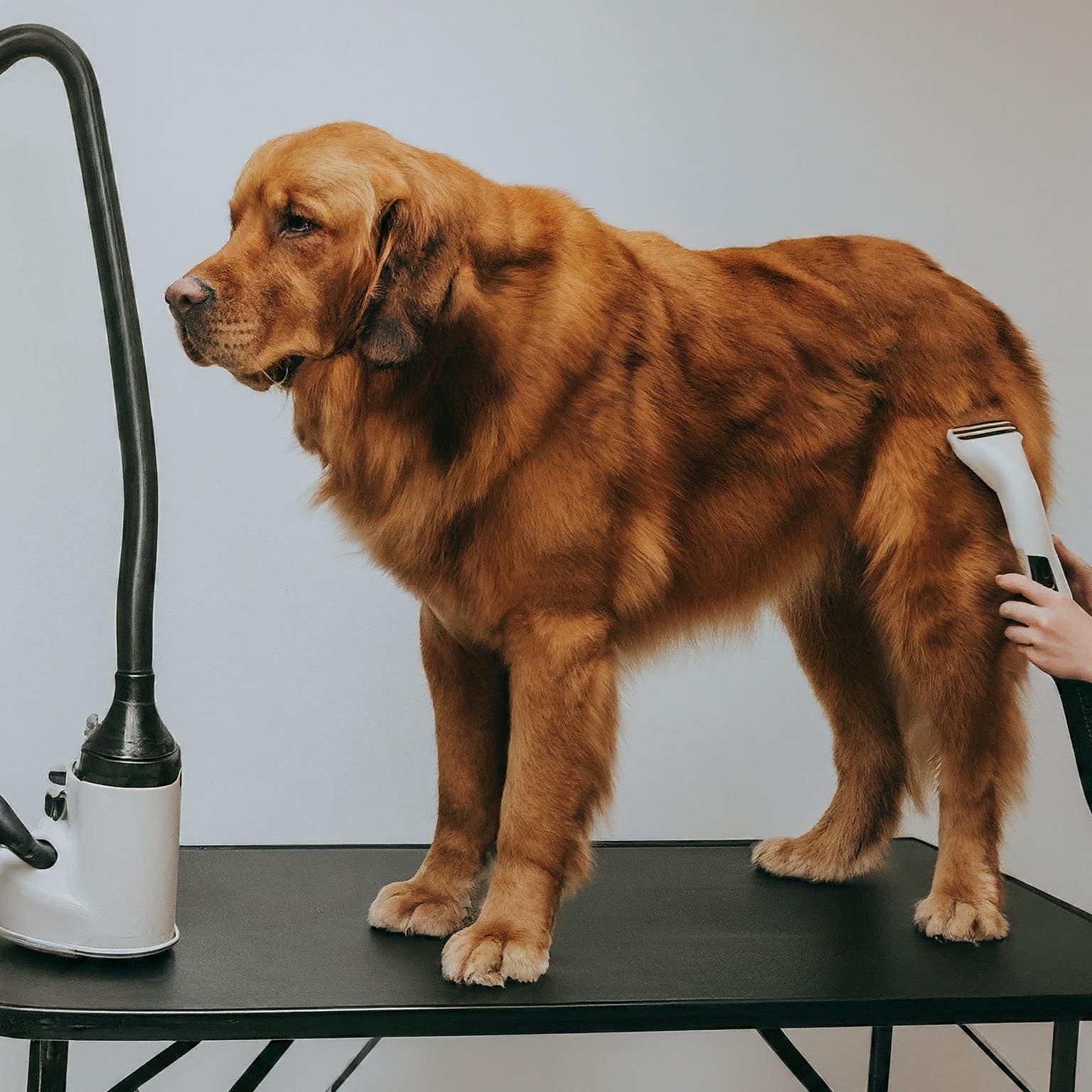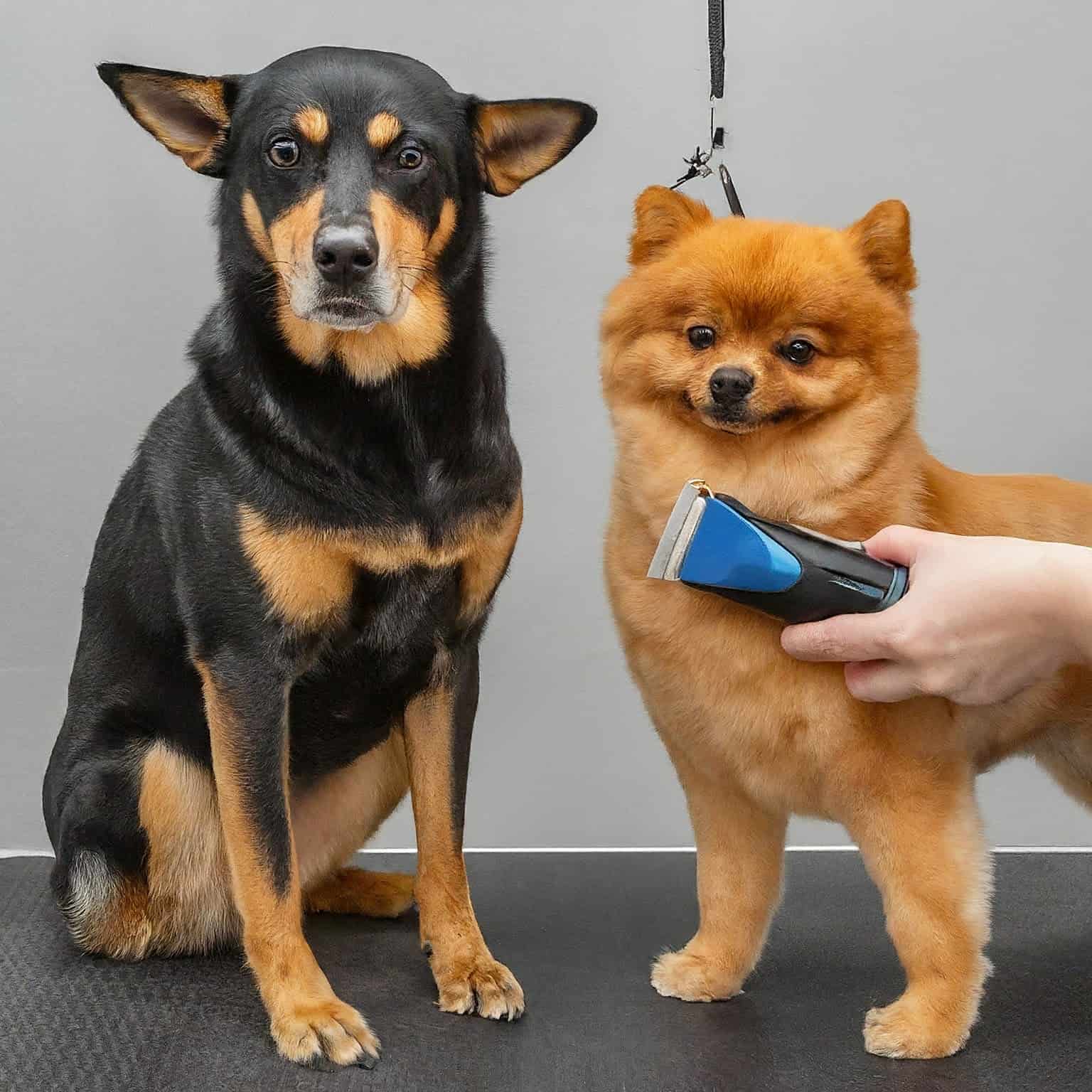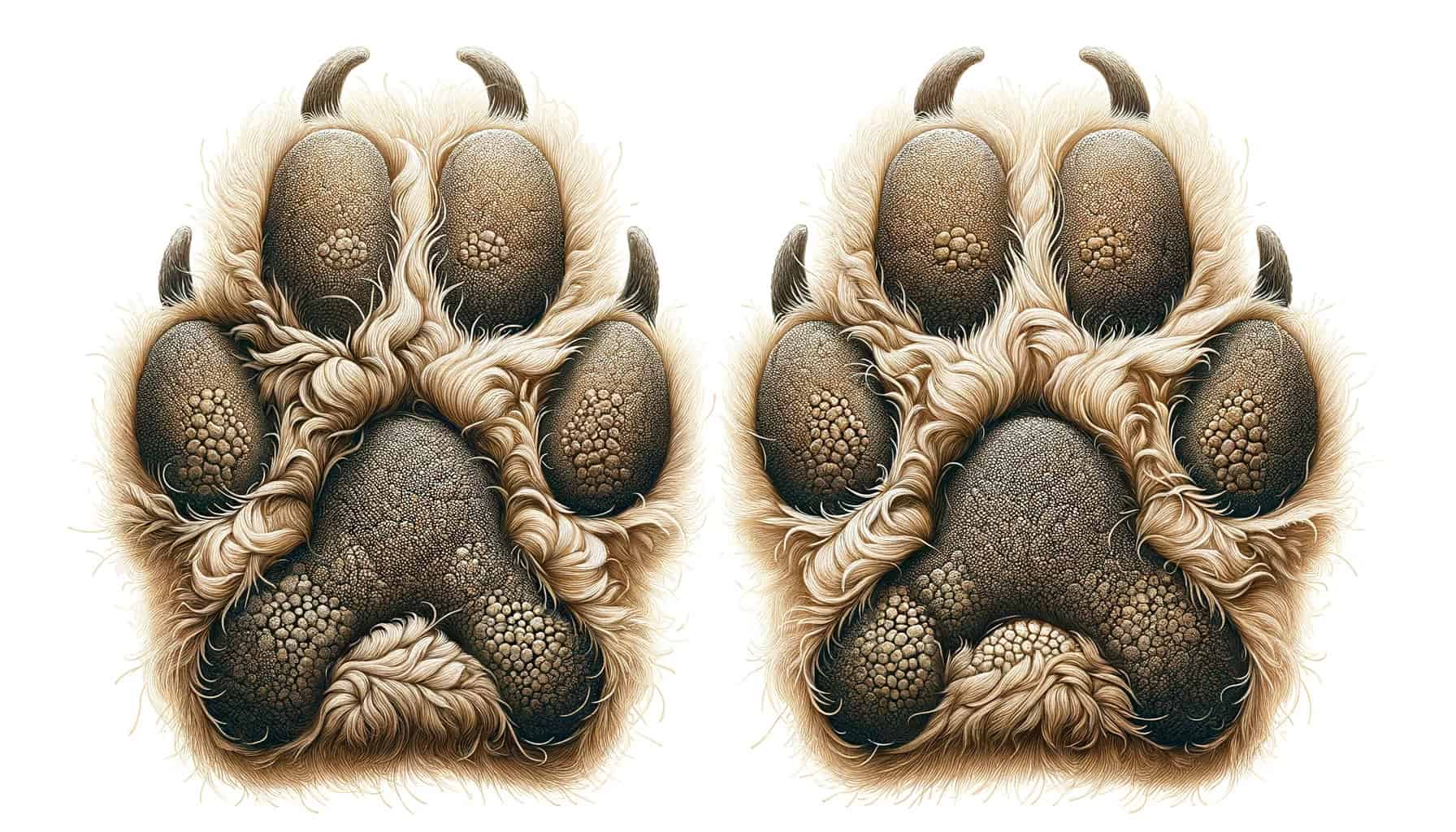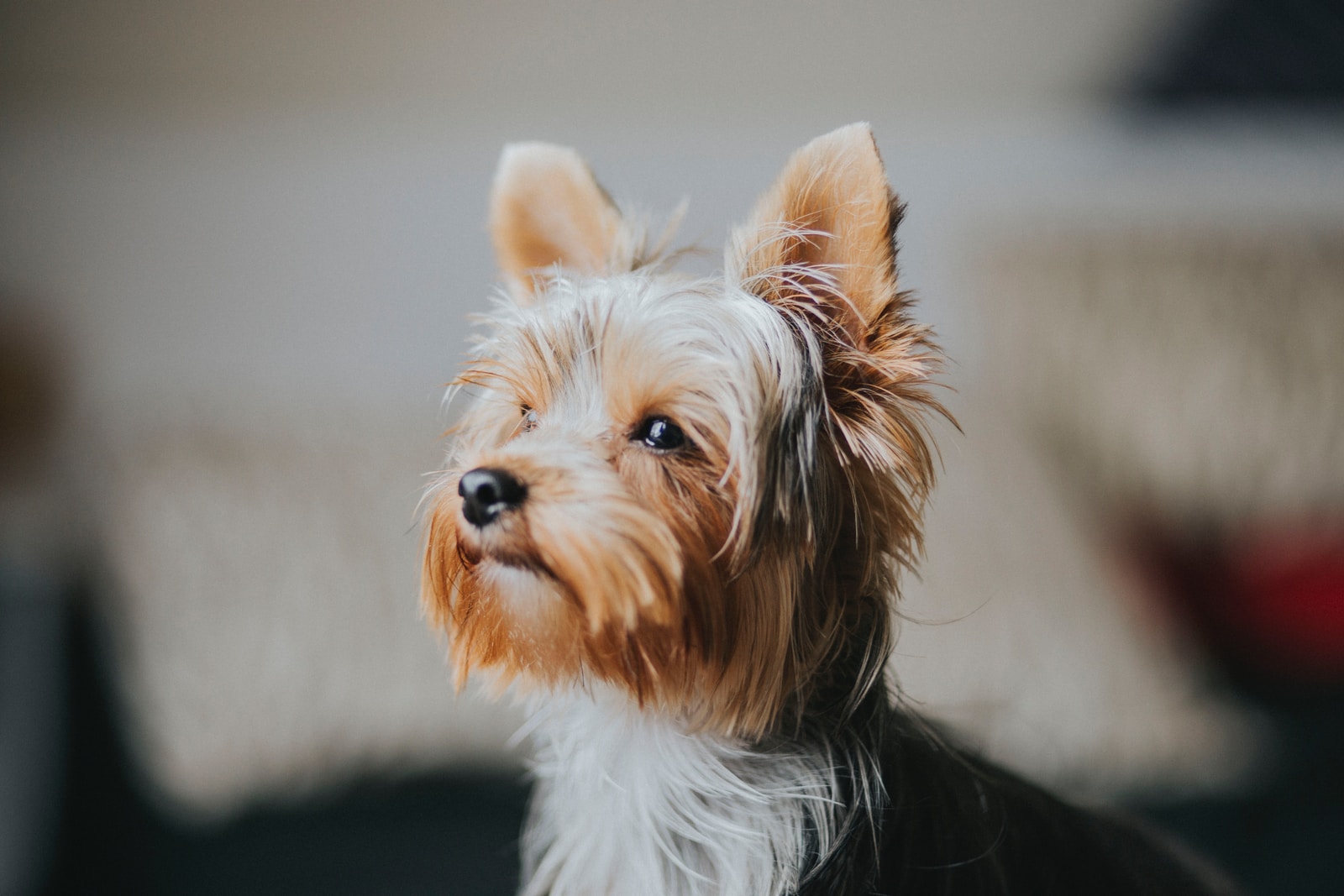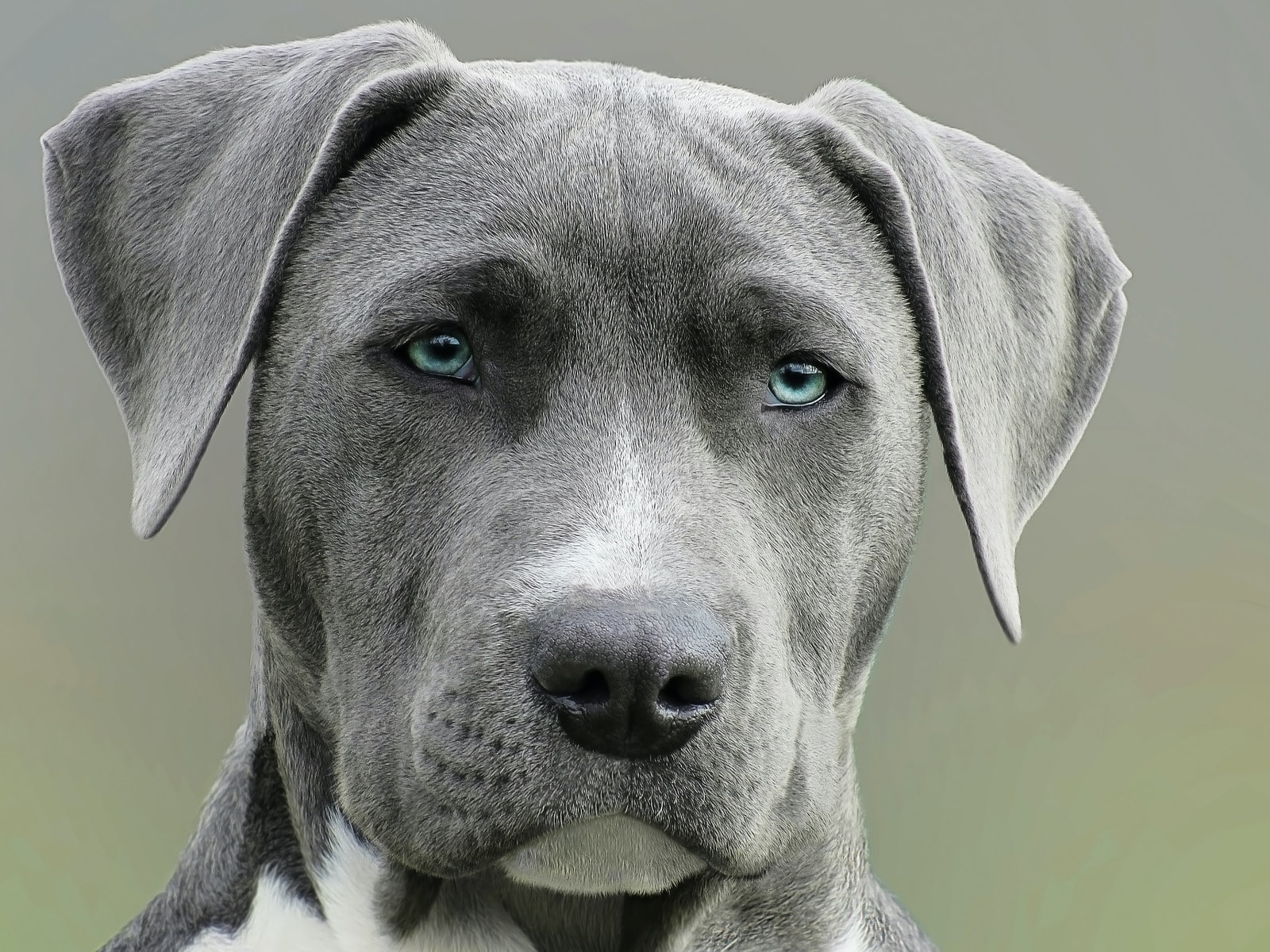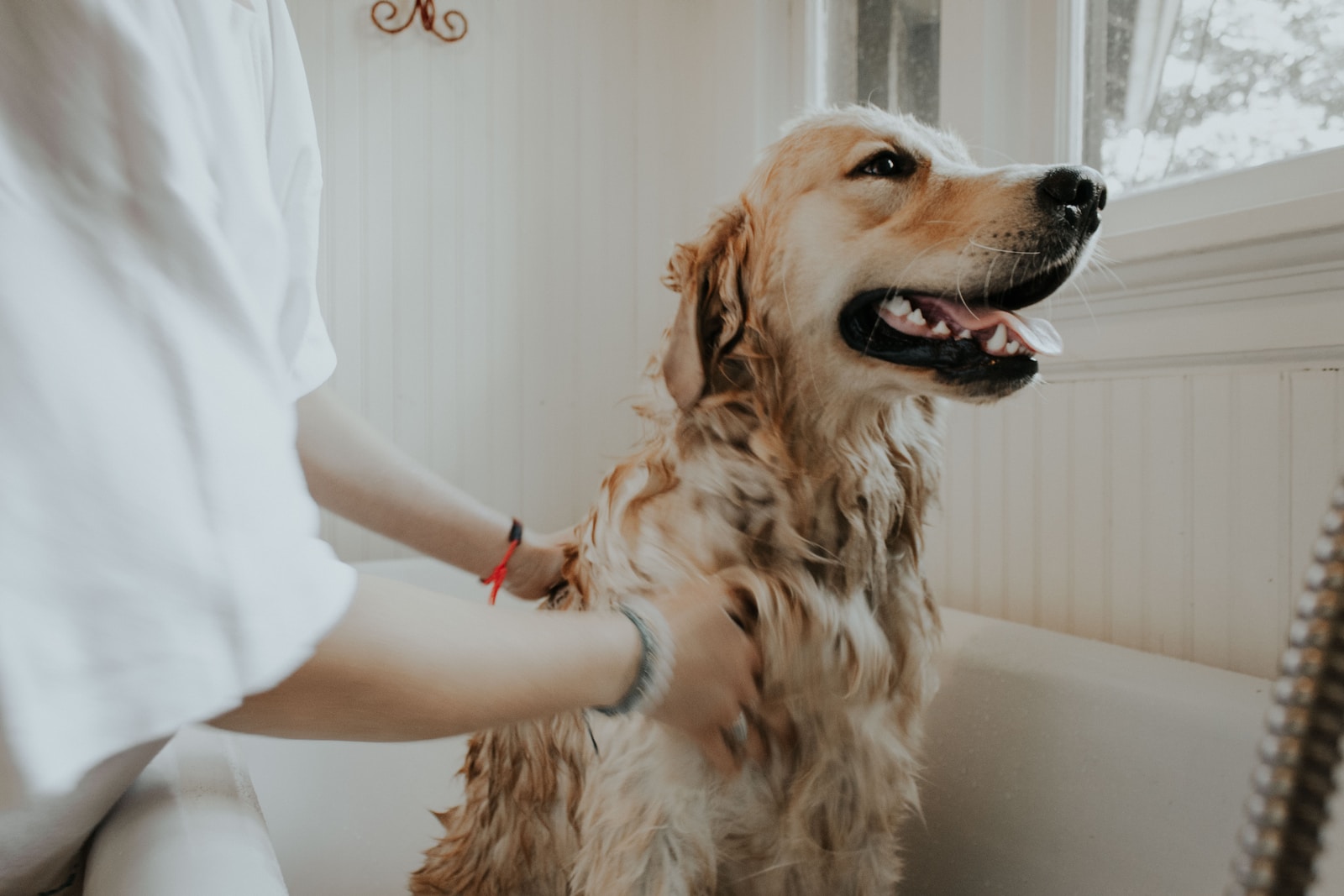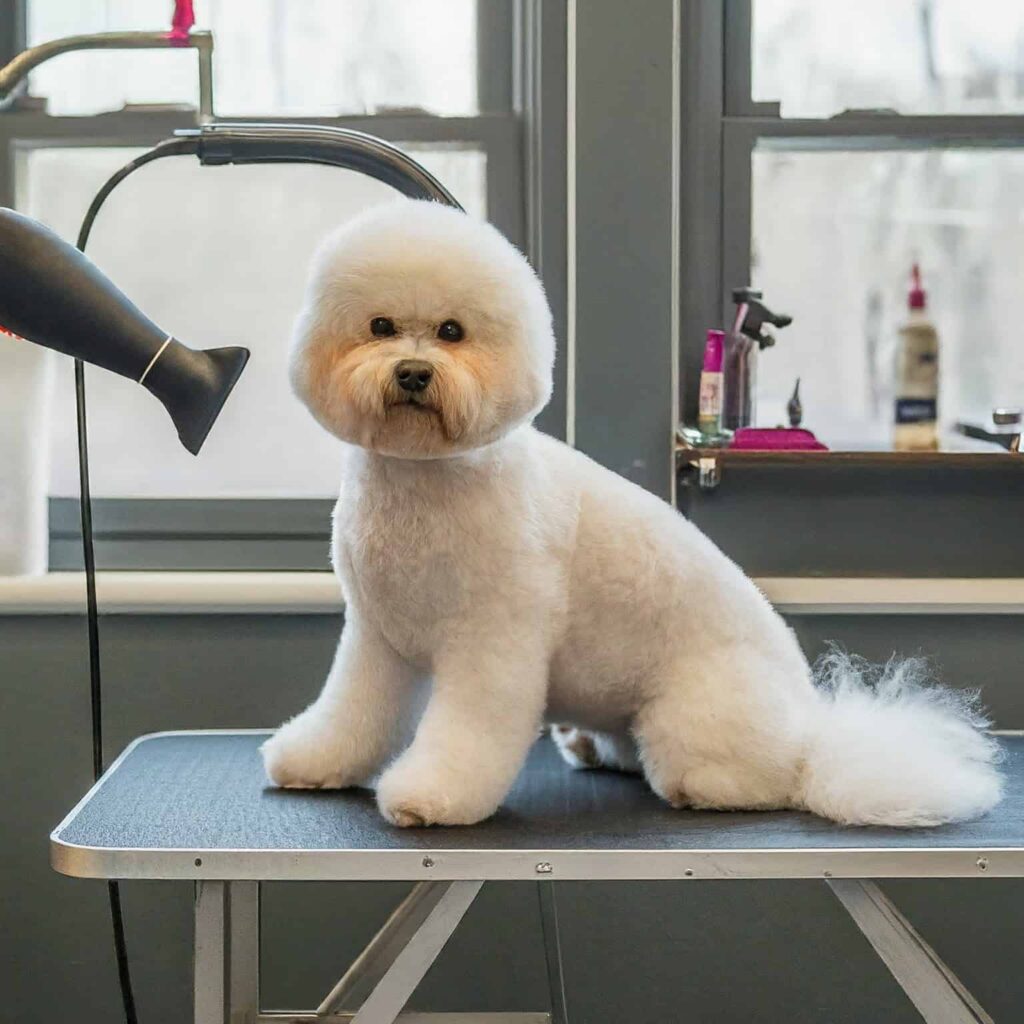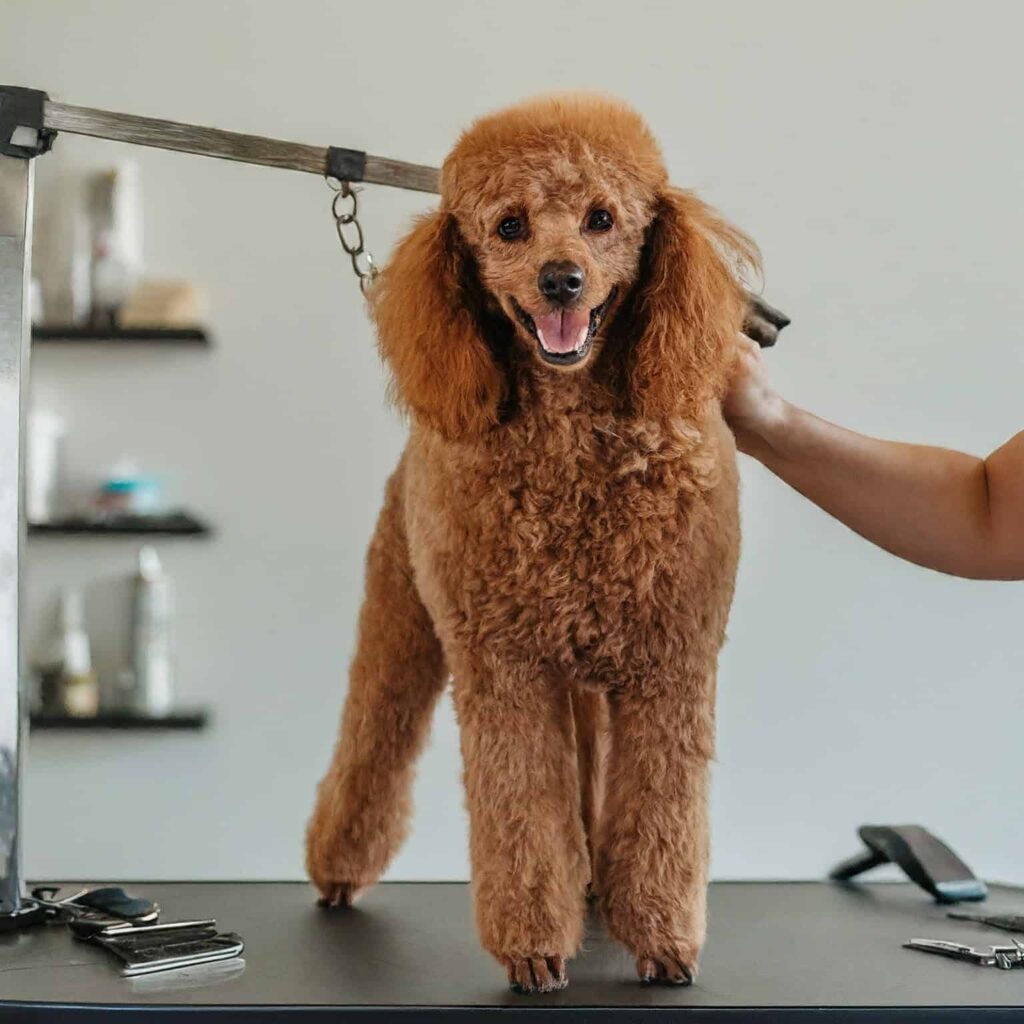The Essentials of Dog Grooming
Why Grooming Matters
Grooming keeps dogs clean and comfortable. It removes dirt and loose fur, helps spot health issues like skin infections and lumps early, and reduces itching. Plus, it strengthens your bond with your dog.
Tailoring Grooming to Your Dog
Each dog is different. Long-haired dogs need frequent brushing, while short-haired dogs still need care. Regular baths keep the skin healthy, nail trimming prevents pain, ear cleaning prevents infections, and dental care keeps teeth and gums healthy.
Know your dog’s needs. Ask your vet for advice and learn about your dog’s breed to make grooming easier and more effective. Groom your dog regularly to keep them happy and healthy.
The Benefits of Grooming for Dogs
Maintaining a Healthy Coat and Skin
Grooming keeps your dog’s coat and skin healthy. Regular brushing removes dirt and debris from the fur. It helps distribute natural oils the skin produces, which keeps the coat shiny and moisturized.
These oils can build up without regular grooming, leading to greasy fur and potential skin problems. Additionally, grooming helps to stimulate blood circulation, which promotes healthy skin.
Preventing Matting and Tangles
Brushing your dog regularly prevents matting and tangles. Mats can form when fur gets tangled and clumps together. They can pull on the skin, causing pain and discomfort. Severe matting can even lead to skin infections or sores.
You remove loose hair and prevent these mats from forming by brushing your dog. For long-haired breeds, daily brushing is crucial. Short-haired breeds benefit from brushing a few times a week.
Reducing Shedding
Shedding is natural, but regular grooming can help manage it. Brushing removes loose hair before it falls out on its own, reducing the amount of fur around your home.
This is especially important during shedding season, when dogs lose their winter coats. Regular baths can also help control shedding by removing dead hair and keeping the coat clean.
Preventing and Identifying Skin Issues and Infections
Regular grooming sessions are a good time to check for skin issues. Look for redness, rashes, bumps, or sores on your dog’s skin. Early detection of these problems can prevent them from becoming more serious.
Regular baths with a dog-friendly shampoo help keep the skin clean and free from irritants that can cause infections. Make sure to dry your dog thoroughly after a bath to prevent moisture-related skin issues.
Promoting Good Oral Hygiene and Preventing Dental Issues
Oral hygiene is a critical part of grooming. Brushing your dog’s teeth removes plaque and prevents tartar buildup. This helps prevent gum disease and tooth decay. Bad breath can indicate dental issues, which regular brushing can help prevent.
Use a toothbrush and toothpaste designed for dogs, and aim to brush their teeth several times a week. Regular dental check-ups with the vet are also important.
Spotting and Addressing Other Health Issues
Grooming provides an opportunity to spot other health issues early. While grooming, check for lumps, bumps, or unusual growths on your dog’s body. Early detection of these can lead to more effective treatment. Look for signs of parasites, such as fleas or ticks, and remove them promptly.
Regular grooming sessions help you become familiar with your dog’s body, making it easier to notice any changes that might indicate health problems.
Regular grooming is more than keeping your dog looking good. It plays a crucial role in maintaining their overall health and well-being. Establishing a consistent grooming routine ensures your dog stays clean, comfortable, and healthy.
Basic Grooming Tools and Products
Brushes and Combs for Different Coat Types
Different coat types need different brushes and combs. Here are some key tools:
- Slicker Brushes: Use slicker brushes for long-haired breeds. They remove mats and tangles.
- Bristle Brushes: These work best for short-haired breeds. They help remove loose hair and add shine.
- Pin Brushes: Pin brushes are good for medium to long-haired dogs. They help detangle and smooth the coat.
- Undercoat Rakes: Use undercoat rakes for breeds with thick undercoats. They help remove loose undercoat hair.
Choosing the right tool keeps your dog’s coat healthy and manageable.
Shampoos and Conditioners for Dogs
Shampoos and conditioners keep your dog’s skin and coat healthy. Here are some options:
- General Dog Shampoo: This is suitable for most dogs. It cleans the coat and keeps it smelling fresh.
- Oatmeal Shampoo: Use oatmeal shampoo for dogs with sensitive skin or allergies. It soothes and moisturizes the skin.
- Medicated Shampoo: This shampoo treats specific skin conditions like dandruff or infections.
- Conditioners: Conditioners detangle fur and add moisture. They make the coat smooth and shiny.
Always choose products formulated for dogs to avoid irritation.
Nail Clippers and Grinders
Keeping your dog’s nails trimmed is important. Here are some tools:
- Guillotine Clippers: These are easy to use and good for small to medium-sized dogs.
- Scissor Clippers: Scissor clippers are suitable for larger dogs with thicker nails.
- Nail Grinders: Nail grinders provide a smooth finish. They are ideal for dogs sensitive to clippers.
Regular nail trimming prevents discomfort and potential injuries.
Ear Cleaning Solutions and Tools
Regular ear cleaning prevents infections. Here are some essentials:
- Ear Cleaning Solutions: These solutions remove wax and debris without irritation.
- Cotton Balls or Pads: Use these to wipe the ear canal gently.
- Ear Wipes: Pre-moistened wipes are great for quick and easy cleaning.
Clean your dog’s ears regularly to keep them healthy.
Dental Hygiene Products for Dogs
Good oral hygiene prevents dental problems. Here are some products:
- Dog Toothbrushes: These fit comfortably in a dog’s mouth and reach all teeth.
- Dog Toothpaste: This toothpaste is safe for dogs if swallowed. It often comes in flavors like chicken or peanut butter.
- Dental Chews and Treats: These help reduce plaque and tartar build-up.
- Oral Rinses: Add oral rinses to water to promote oral health.
Brush your dog’s teeth several times a week to maintain good dental health.
Hair Dryers and Other Grooming Equipment
Proper grooming equipment ensures a smooth grooming process. Here are some key tools:
- Dog Hair Dryers: These dryers dry fur quickly and safely. They are often quieter than human hair dryers.
- Grooming Tables: Grooming tables provide a stable surface for grooming. They make the process easier and safer.
- Grooming Scissors: Use grooming scissors for trimming fur around sensitive areas like the face and paws.
- De-Shedding Tools: These tools remove loose fur, especially during shedding season.
These tools help keep your dog looking their best and make grooming more efficient.
Using the right grooming tools and products is essential for maintaining your dog’s health and appearance. With the proper brushes, shampoos, nail clippers, and other equipment, you can ensure your dog stays clean, comfortable, and healthy.
Coat Maintenance
Understanding Different Coat Types
Different dogs have different coat types, which need different care:
- Short Coats: Smooth and close to the body. Easy to groom. Brush weekly to remove loose hair.
- Medium Coats: Slightly longer, can be wavy or straight. Brush several times a week to prevent tangles.
- Long Coats: Long, flowing hair. Needs daily brushing to prevent mats and tangles.
- Curly Coats: Tight curls, like Poodles. Brush daily to prevent mats. Regular trimming is needed.
- Double Coats: Two layers – a soft undercoat and a harsh topcoat. Brush weekly, more during shedding seasons.
Knowing your dog’s coat type helps you choose the right grooming routine.
Seasonal Coat Changes
Dogs shed more during seasonal changes. Here’s what to expect:
- Spring and Fall: Dogs shed their undercoat. Brush more frequently to remove loose hair.
- Summer: Some breeds shed their thick winter coat. Regular brushing helps keep them cool.
- Winter: Dogs grow a thicker coat. Regular brushing prevents matting and tangles.
Understanding these changes helps you manage shedding and maintain a healthy coat.
Preventing Matting and Tangling
Preventing mats and tangles is essential for a healthy coat. Follow these steps:
- Brush Regularly: Brush your dog based on their coat type. Regular brushing prevents mats and tangles.
- Use the Right Tools: Choose brushes and combs suited for your dog’s coat. Slicker brushes and undercoat rakes work well for long and double coats. Bristle brushes are good for short coats.
- Check for Mats: Pay attention to areas prone to matting, like behind the ears, under the legs, and around the collar.
- Remove Mats Carefully: If you find a mat, use a detangling spray. Gently work it out with a comb. Avoid pulling, which can hurt your dog.
- Trim Problem Areas: Keep the hair short in areas that mat easily. This reduces the chance of tangles.
Regular grooming and the right techniques keep your dog’s coat smooth and healthy. By understanding coat types and seasonal changes, you can provide the best care for your dog’s coat.
Grooming Techniques for Different Coat Types
Short-Haired Breeds
Short-haired breeds need simple grooming:
- Brush Weekly: Use a bristle brush or rubber curry brush. Brush in the direction of hair growth.
- Bath Occasionally: Bathe every 4-6 weeks. Use a mild dog shampoo.
- Wipe Down: Use a damp cloth between baths to remove dirt and loose hair.
- Check Skin: Look for redness or irritation. Short coats make it easy to spot skin issues.
Regular brushing keeps short-haired breeds clean and shiny.
Medium-Haired Breeds
Medium-haired breeds need more frequent grooming:
- Brush Several Times a Week: Use a pin brush or slicker brush. Detangle any knots gently.
- Bathe Monthly: Use a gentle dog shampoo. Rinse thoroughly to avoid residue.
- Trim As Needed: Trim around the feet and hindquarters to keep them neat.
- Check for Tangles: Pay extra attention to areas like behind the ears and under the legs.
Regular grooming prevents matting and keeps the coat healthy.
Long-Haired Breeds
Long-haired breeds require daily grooming:
- Brush Daily: Use a slicker brush or pin brush. Start at the base and work your way up.
- Detangle Gently: Use a detangling spray for stubborn knots. Be gentle to avoid pulling.
- Bathe Every 4-6 Weeks: Use a moisturizing dog shampoo. Condition the coat to keep it smooth.
- Trim Regularly: Trim the hair around the face, paws, and sanitary areas.
Daily grooming keeps long-haired coats free from tangles and mats.
Wiry and Curly-Haired Breeds
Wiry and curly-haired breeds need special care:
- Brush Every Few Days: Use a slicker brush. Curly coats need more frequent brushing to prevent matting.
- Hand-Strip for Wiry Coats: Pluck dead hair by hand or use a stripping knife. This maintains the coat’s texture.
- Bathe Every 4-6 Weeks: Use a shampoo designed for wiry or curly coats. Rinse thoroughly.
- Regular Trimming: Trim curly coats to prevent matting. Wiry coats may need hand-stripping.
Special care keeps wiry and curly coats looking their best.
Double-Coated Breeds
Double-coated breeds need thorough grooming:
- Brush Weekly: Use an undercoat rake followed by a slicker brush. Remove loose undercoat hair.
- Bathe Seasonally: Bathe more during shedding seasons. Use a de-shedding shampoo.
- Dry Thoroughly: Dry the coat completely after bathing to prevent mold or mildew.
- Check for Mats: Pay attention to the undercoat. Mats can form if not properly brushed.
Regular grooming and attention to both layers keep double coats healthy and manageable.
Proper grooming techniques tailored to each coat type ensure a healthy, comfortable dog. Regular brushing, bathing, and trimming keep the coat clean and free from mats. Use the right tools and methods for your dog’s specific coat type for the best results.
| Dog Breed | Hair Type |
|---|---|
| Labrador Retriever | Short-haired |
| German Shepherd | Double-coated |
| Golden Retriever | Double-coated |
| French Bulldog | Short-haired |
| Bulldog | Short-haired |
| Beagle | Short-haired |
| Poodle | Wiry and curly-haired |
| Rottweiler | Short-haired |
| Yorkshire Terrier | Long-haired |
| Boxer | Short-haired |
| Dachshund | Short-haired |
| Pembroke Welsh Corgi | Medium-haired |
| Australian Shepherd | Double-coated |
| Shih Tzu | Long-haired |
| Siberian Husky | Double-coated |
| Great Dane | Short-haired |
| Doberman Pinscher | Short-haired |
| Miniature Schnauzer | Wiry and curly-haired |
| Cavalier King Charles Spaniel | Medium-haired |
| Shetland Sheepdog | Double-coated |
| Boston Terrier | Short-haired |
| Havanese | Long-haired |
| Bernese Mountain Dog | Double-coated |
| Pomeranian | Double-coated |
| Maltese | Long-haired |
| Chihuahua | Short-haired, Long-haired |
| Pug | Short-haired |
| Cocker Spaniel | Medium-haired |
| Border Collie | Double-coated |
| Bichon Frise | Wiry and curly-haired |
| West Highland White Terrier | Medium-haired |
| Vizsla | Short-haired |
| Newfoundland | Double-coated |
| Collie | Double-coated |
| English Springer Spaniel | Medium-haired |
| American Staffordshire Terrier | Short-haired |
| Shiba Inu | Double-coated |
| Akita | Double-coated |
| Cane Corso | Short-haired |
| Alaskan Malamute | Double-coated |
Dealing with Shedding
Managing Shedding
Managing shedding is essential for keeping your home clean and your dog comfortable. Regular brushing helps remove loose hair before it falls out. During peak shedding seasons, brush your dog more frequently.
Bathing your dog with a de-shedding shampoo can also help. Ensure your dog’s diet is balanced; a healthy diet promotes a healthy coat, which can reduce excessive shedding. Keep your home clean by vacuuming regularly and using furniture covers.
Tools to Control Shedding
Using the right tools makes controlling shedding easier. Here are some effective tools:
- Undercoat Rake: Removes loose undercoat hair. Ideal for double-coated breeds.
- Slicker Brush: Good for all coat types. Removes loose hair and prevents matting.
- De-shedding Tool: Specially designed to remove loose fur from the undercoat without damaging the topcoat.
- Rubber Curry Brush: Effective for short-haired breeds. Removes loose hair and stimulates the skin.
- De-shedding Shampoo: Helps remove loose hair during baths. Keeps the coat clean and healthy.
These tools help manage shedding and keep your dog’s coat healthy.
Breeds That Shed the Most
Some breeds shed more than others. Here are some heavy shedders:
- Labrador Retriever: Sheds year-round, with peak seasons in spring and fall.
- German Shepherd: Sheds heavily, especially during seasonal changes.
- Golden Retriever: Constant shedding with increased shedding during spring and fall.
- Siberian Husky: Sheds heavily twice a year during seasonal coat changes.
- Alaskan Malamute: Similar to the Husky, sheds heavily during spring and fall.
- Pomeranian: Sheds year-round, with seasonal shedding periods.
- Bernese Mountain Dog: Sheds heavily, especially during seasonal changes.
- Akita: Sheds heavily twice a year during seasonal coat changes.
- Corgi: Sheds year-round with increased shedding during spring and fall.
- Newfoundland: Sheds heavily, especially during seasonal changes.
Understanding which breeds shed the most helps you prepare for managing their shedding.
Managing shedding involves regular grooming and using the right tools. By brushing frequently, using de-shedding tools, and maintaining a healthy diet, you can reduce the amount of loose hair in your home. Recognizing breeds that shed heavily allows you to take extra steps to manage their shedding effectively.
Grooming Puppies
Introducing Grooming to Puppies
Start grooming your puppy early. Begin with short sessions. Use gentle tools. Let your puppy sniff the tools. Brush gently and briefly. Praise and reward your puppy. Gradually increase the length of sessions. This helps your puppy get used to grooming.
Special Considerations for Young Dogs
Young dogs have different needs. Use gentle brushes. Puppy skin is sensitive. Avoid harsh shampoos. Use products designed for puppies. Be careful with nails. Puppy nails are softer. Use small clippers. Be gentle around the ears and face. Puppies are more sensitive in these areas.
Building Positive Grooming Experiences
Make grooming positive. Use treats and praise. Stay calm and patient. Create a routine. Groom at the same time and place. Take breaks if your puppy gets restless. Gradually introduce new grooming tasks.
Start with brushing, then move to bathing and nail trimming. Use gentle handling. Build trust with your puppy. A positive experience makes grooming easier as your puppy grows.
Grooming puppies sets the foundation for good grooming habits. Start early, use gentle tools, and make it a positive experience. This helps your puppy grow into a well-groomed and happy dog.
Senior Dog Grooming
Adjusting Grooming for Older Dogs
Senior dogs need special grooming care. Their coats may become thinner or coarser. Brush gently to avoid irritating their skin. Use soft-bristle brushes. Bathe less frequently to prevent dry skin. Choose a mild, moisturizing shampoo. Handle your senior dog with extra care. Their joints may be stiff or painful.
Health Issues to Watch For
Watch for health issues in senior dogs. Look for lumps or bumps on their skin. Check for signs of arthritis, like difficulty moving or standing. Monitor their weight. Sudden weight changes can signal health problems.
Examine their teeth and gums regularly. Dental issues are common in older dogs. Keep an eye on their eyes and ears for signs of infections or cataracts.
Comfort-Focused Grooming
Make grooming comfortable for senior dogs. Create a calm environment. Use a non-slip mat during baths to prevent falls. Trim nails carefully. Older dogs may have more brittle nails.
Keep grooming sessions short to avoid tiring them out. Use warm water for baths. Cold water can be uncomfortable for senior dogs. Dry them thoroughly but gently.
Senior dog grooming requires adjustments to ensure comfort and health. Use gentle tools, monitor for health issues, and create a soothing grooming experience. This keeps your senior dog clean, healthy, and happy.
Bathing Your Dog
How Often to Bathe
Bathing frequency depends on your dog’s breed, coat type, and lifestyle. Generally, dogs need a bath every four to six weeks. Dogs with oily coats may need baths more often, while those with dry skin should bathe less frequently. Active dogs who get dirty often may need more regular baths. Consult your vet for specific recommendations.
Choosing the Right Shampoo
Using the right shampoo is crucial. Here are some types to consider:
- General Dog Shampoo: Suitable for most dogs. Keeps the coat clean and fresh.
- Oatmeal Shampoo: Ideal for dogs with sensitive skin. It soothes and moisturizes.
- Medicated Shampoo: Used to treat specific skin conditions like dandruff or infections.
- Hypoallergenic Shampoo: Good for dogs with allergies. It minimizes irritation.
- Flea and Tick Shampoo: Helps control parasites. Effective during flea and tick season.
Always choose shampoos formulated for dogs to avoid skin irritation.
Bathing Techniques
Proper bathing techniques ensure a clean and happy dog. Follow these steps:
- Prepare the Bathing Area: Use a bathtub or a large basin. Place a non-slip mat to prevent slipping.
- Brush Before Bathing: Remove tangles and loose fur. This makes bathing more effective.
- Wet the Coat: Use lukewarm water. Avoid the eyes and ears.
- Apply Shampoo: Use a small amount. Work it into a lather, starting from the neck and moving down.
- Rinse Thoroughly: Ensure all shampoo is removed. Leftover shampoo can irritate the skin.
- Apply Conditioner (if needed): Apply and leave it in for a few minutes. Rinse thoroughly.
- Dry the Dog: Use a towel to remove excess water. A dog hair dryer can help dry the coat completely. Keep the dryer on a low, cool setting to avoid burns.
- Reward Your Dog: Give treats and praise to create a positive association with bathing.
By following these steps, you ensure a thorough and comfortable bath for your dog. Regular bathing keeps your dog clean, healthy, and happy.
Brushing and Combing
Benefits of Regular Brushing
Regular brushing offers many benefits for your dog. It removes loose hair, dirt, and debris. Brushing helps distribute natural oils, keeping the coat shiny and healthy. It prevents matting and tangles, which can cause discomfort. Regular brushing also helps you spot skin issues early, like rashes or parasites. It strengthens the bond between you and your dog, making grooming a positive experience.
Types of Brushes and Combs
Different brushes and combs serve different purposes. Here are some key types:
- Slicker Brushes: Use for long-haired breeds. They remove mats and tangles effectively.
- Bristle Brushes: Ideal for short-haired breeds. They remove loose hair and add shine.
- Pin Brushes: Suitable for medium to long-haired dogs. They help detangle and smooth the coat.
- Undercoat Rakes: Best for breeds with thick undercoats. They remove loose undercoat hair.
- Combs: Use for detailed grooming. They help remove small mats and tangles.
Choosing the right tool makes brushing easier and more effective.
Techniques for Different Coats
Different coat types require different brushing techniques. Here are some guidelines:
- Short Coats: Use a bristle brush or rubber curry brush. Brush in the direction of hair growth. Short, gentle strokes work best.
- Medium Coats: Use a pin brush or bristle brush. Start at the head and work your way down. Pay extra attention to areas prone to tangling, like behind the ears.
- Long Coats: Use a slicker brush or pin brush. Brush in sections to ensure thorough grooming. Start at the base of the hair and work your way up. Be gentle to avoid pulling on mats.
- Double Coats: Use an undercoat rake followed by a slicker brush. Remove loose undercoat hair first, then brush the topcoat. Brush in the direction of hair growth.
- Curly Coats: Use a slicker brush. Brush in small sections to avoid tangling. Be gentle to prevent breakage.
Brushing regularly keeps your dog’s coat healthy and reduces shedding. Use the right tools and techniques for your dog’s specific coat type. This ensures a comfortable and effective grooming experience.
Handling Skin Issues
Identifying Skin Problems
Identifying skin problems early is crucial. Look for these signs:
- Redness: Indicates irritation or infection.
- Bumps: Could be cysts, tumors, or insect bites.
- Dry, Flaky Skin: Suggests allergies or poor diet.
- Hair Loss: May signal mange, fleas, or hormonal issues.
- Excessive Scratching: Often a sign of parasites or allergies.
Regularly check your dog’s skin to catch problems early.
Grooming with Skin Conditions
Grooming with skin conditions requires care. Follow these steps:
- Use Gentle Tools: Soft-bristle brushes or grooming gloves reduce irritation.
- Bathe with Caution: Use lukewarm water. Hot water can worsen skin issues.
- Choose Mild Shampoos: Medicated or hypoallergenic shampoos are best.
- Dry Thoroughly: Gently pat dry with a soft towel. Avoid rubbing, which can irritate the skin.
- Trim Hair Carefully: Keep the hair short around affected areas to promote healing.
Always consult your vet for specific grooming instructions related to your dog’s skin condition.
Products for Sensitive Skin
Using the right products is essential for dogs with sensitive skin. Here are some recommendations:
- Hypoallergenic Shampoos: Free from harsh chemicals and fragrances. Suitable for sensitive skin.
- Oatmeal-Based Shampoos: Soothes and moisturizes the skin. Reduces itching and inflammation.
- Aloe Vera Gel: Natural and soothing. Helps heal minor skin irritations.
- Coconut Oil: Moisturizes and soothes dry skin. Apply a small amount to affected areas.
- Medicated Shampoos: Contains ingredients like chlorhexidine or ketoconazole. Treats specific skin conditions. Use as directed by your vet.
Choosing the right products helps manage and prevent skin issues.
Handling skin issues involves regular checks, gentle grooming, and using the right products. Identifying problems early and adjusting grooming techniques ensures your dog’s skin stays healthy and irritation-free.
Flea and Tick Prevention
Identifying Fleas and Ticks
Identifying fleas and ticks quickly helps prevent infestations. Look for these signs:
- Fleas: Small, dark brown insects. They move quickly through the fur. Look for flea dirt (black specks) on the skin. Flea dirt turns red when wet.
- Ticks: Small, round parasites. They attach to the skin and swell as they feed. Common places include around the ears, neck, and between toes.
Regularly check your dog for these pests, especially after outdoor activities.
Preventative Products
Using preventative products keeps fleas and ticks at bay. Here are some effective options:
- Topical Treatments: Applied to the skin. Kills and repels fleas and ticks. Examples include Frontline and Advantage.
- Oral Medications: Given as a chewable tablet. Works systemically to kill fleas and ticks. Examples include NexGard and Bravecto.
- Flea Collars: Worn around the neck. Releases active ingredients to repel and kill fleas and ticks. Examples include Seresto and Hartz.
- Sprays and Powders: Applied to the coat and bedding. Provides additional protection. Examples include Adams and Zodiac.
- Shampoos: Used during baths. Kills fleas and ticks on contact. Examples include Sentry and Vet’s Best.
Choose products based on your dog’s needs and follow the manufacturer’s instructions.
Grooming to Remove Pests
Grooming helps remove fleas and ticks. Follow these steps:
- Use a Fine-Toothed Flea Comb: Comb through the fur, focusing on areas where fleas hide. Dip the comb in soapy water to kill fleas.
- Check for Ticks: Run your hands over your dog’s body to feel for ticks. Use tweezers to remove them. Grasp the tick close to the skin and pull straight out.
- Bathe with Flea Shampoo: Use a flea shampoo during baths. Follow the product instructions for best results.
- Clean Bedding and Environment: Wash your dog’s bedding in hot water. Vacuum carpets and furniture to remove flea eggs and larvae.
Regular grooming and environmental cleaning help keep pests under control.
Flea and tick prevention involves regular checks, using preventative products, and grooming to remove pests. By staying vigilant and using the right tools, you can keep your dog free from these parasites.
Nail Care
Importance of Nail Trimming
Regular nail trimming is essential for your dog. Overgrown nails can cause pain and discomfort. They can lead to walking difficulties and joint issues. Long nails are more prone to breaking, which can cause infections. Regular trimming keeps your dog comfortable and healthy.
Tools for Nail Care
Choosing the right tools makes nail trimming easier. Here are the main options:
- Guillotine Clippers: Easy to use for small to medium-sized dogs. They provide a clean cut.
- Scissor Clippers: Suitable for larger dogs with thicker nails. They offer better leverage.
- Nail Grinders: Smooth the nails after clipping. Ideal for dogs sensitive to clippers.
- Styptic Powder: Stops bleeding if you cut the nail too short. Keep it handy during trimming.
Using the right tools ensures a safe and effective nail trimming session.
Step-by-Step Nail Trimming
Follow these steps to trim your dog’s nails safely:
- Prepare the Tools: Gather clippers, a nail grinder, and styptic powder. Ensure they are clean and in good condition.
- Calm Your Dog: Keep your dog calm and comfortable. Use treats and soothing words.
- Hold the Paw: Gently hold your dog’s paw. Press the pad to extend the nails.
- Identify the Quick: Locate the quick, the pink area inside the nail. Avoid cutting it to prevent bleeding.
- Trim the Nail: Cut a small portion of the nail at a time. Trim at a slight angle, away from the quick.
- Check and Trim: Examine the nail after each cut. Trim until the nail is just above the quick.
- Smooth the Edges: Use a nail grinder to smooth rough edges. This prevents snagging and discomfort.
- Reward Your Dog: Give treats and praise. This makes nail trimming a positive experience.
Regular nail trimming keeps your dog comfortable and prevents health issues. Follow these steps and use the right tools for a safe trimming session.
Ear Cleaning
Why Ear Care Matters
Ear care is crucial for your dog’s health. Regular cleaning prevents infections. It removes wax and debris. Clean ears reduce the risk of ear mites and other parasites. Neglecting ear care can lead to pain and hearing loss. Regular ear cleaning keeps your dog comfortable and healthy.
Signs of Ear Problems
Recognizing signs of ear problems is important. Look for these indicators:
- Redness: Red ears can signal irritation or infection.
- Odor: A foul smell often indicates an infection.
- Discharge: Brown, yellow, or bloody discharge is a warning sign.
- Scratching: Excessive scratching or head shaking suggests discomfort.
- Swelling: Swollen ears may indicate an underlying issue.
If you notice these signs, consult your vet promptly.
Cleaning Techniques
Proper cleaning techniques keep your dog’s ears healthy. Follow these steps:
- Gather Supplies: You need ear cleaning solution, cotton balls or pads, and treats.
- Calm Your Dog: Keep your dog calm and still. Use soothing words and treats.
- Inspect the Ears: Check for redness, discharge, or odor. If you see any issues, consult your vet before cleaning.
- Apply the Solution: Pour the ear cleaning solution into the ear canal. Follow the product instructions for the right amount.
- Massage the Base: Gently massage the base of the ear. This helps the solution break up wax and debris.
- Wipe the Ear: Use a cotton ball or pad to wipe away the solution, wax, and debris. Be gentle to avoid irritation.
- Dry the Ear: Use a clean, dry cotton ball to remove any remaining moisture. Dry ears help prevent infections.
- Reward Your Dog: Give treats and praise. This creates a positive association with ear cleaning.
Regular ear cleaning keeps your dog’s ears free of wax and debris, preventing infections and discomfort. Use proper techniques and be gentle to ensure a positive experience for your dog.
Dental Care
Importance of Oral Hygiene
Oral hygiene is vital for your dog’s health. It prevents plaque and tartar buildup. This reduces the risk of gum disease and tooth decay. Good oral hygiene also prevents bad breath. Neglecting dental care can lead to pain and infections. Regular dental care keeps your dog healthy and comfortable.
Tools for Dental Care
Using the right tools makes dental care effective. Here are some essentials:
- Dog Toothbrush: Designed to fit a dog’s mouth. It reaches all teeth.
- Dog Toothpaste: Safe for dogs to swallow. Comes in flavors like chicken or peanut butter.
- Dental Chews: Help reduce plaque and tartar. They also freshen breath.
- Oral Rinses: Added to water to promote oral health. They reduce bacteria in the mouth.
These tools ensure comprehensive dental care for your dog.
Brushing Your Dog’s Teeth
Brushing your dog’s teeth is key to good oral hygiene. Follow these steps:
- Gather Supplies: You need a dog toothbrush, dog toothpaste, and treats.
- Calm Your Dog: Keep your dog calm and still. Use soothing words and treats.
- Lift the Lip: Gently lift your dog’s lip to expose the teeth and gums.
- Apply Toothpaste: Put a small amount of dog toothpaste on the brush. Do not use human toothpaste.
- Brush the Teeth: Brush in small circles, focusing on the gum line. Brush all teeth, including the back molars.
- Be Gentle: Use gentle pressure to avoid hurting the gums. Take breaks if your dog becomes restless.
- Rinse (Optional): Use a damp cloth to wipe the mouth. This removes any remaining toothpaste.
- Reward Your Dog: Give treats and praise. This makes brushing a positive experience.
Regular brushing prevents dental issues and keeps your dog’s mouth healthy. Use the right tools and techniques for effective dental care.
Eye Care
Identifying Eye Issues
Recognizing eye issues early is crucial for your dog’s health. Look for these signs:
- Redness: Red eyes can indicate irritation or infection.
- Discharge: Clear, yellow, or green discharge may signal an issue.
- Swelling: Swollen eyes or eyelids can indicate inflammation.
- Cloudiness: Cloudy eyes might point to cataracts or other eye problems.
- Excessive Tearing: Constant tearing can be a sign of irritation or blocked tear ducts.
If you notice any of these signs, consult your vet promptly.
Cleaning Around the Eyes
Cleaning your dog’s eyes keeps them healthy and comfortable. Follow these steps:
- Gather Supplies: You need a damp cloth or cotton ball and saline solution or distilled water.
- Calm Your Dog: Keep your dog calm and still. Use soothing words and treats.
- Wipe Gently: Moisten the cloth or cotton ball. Gently wipe from the inner corner of the eye outward. Use a separate cloth or cotton ball for each eye to prevent spreading infection.
- Remove Debris: Remove any crust or discharge. Be gentle to avoid irritation.
- Dry the Area: Use a dry cloth to pat the area dry. Keeping the area dry prevents infections.
Regular cleaning keeps your dog’s eyes clear and healthy.
Preventing Tear Stains
Tear stains can be unsightly and indicate underlying issues. Here are some tips to prevent them:
- Clean Regularly: Wipe the eyes daily with a damp cloth to remove tear stains.
- Use Tear Stain Removers: Products specifically designed to remove and prevent tear stains can be effective.
- Check Diet: Sometimes, food allergies can cause excessive tearing. Consult your vet about dietary changes.
- Provide Clean Water: Filtered water can reduce tear staining caused by minerals in tap water.
- Keep Hair Trimmed: Trim the hair around the eyes to prevent irritation and reduce staining.
By following these steps, you can prevent tear stains and keep your dog’s eyes bright and clear. Regular eye care ensures your dog’s eyes stay healthy and free from irritation.
Professional Grooming
When to Seek Professional Help
Professional grooming is essential in certain situations. Dogs with complex grooming needs, like Poodles or Shih Tzus, benefit greatly from professional care. Severe matting, which can be difficult and painful to address at home, also warrants professional attention.
Dogs with skin conditions requiring special treatments, such as medicated baths, should be groomed by experts. Additionally, if nail trimming is challenging or if your dog becomes anxious or aggressive during grooming, seeking professional help ensures safety and effectiveness.
Finding a Professional Groomer
Choosing the right groomer requires careful consideration. Start by asking about their experience and training, as well as the range of services they provide, including breed-specific cuts or medicated baths.
Inquire about their handling techniques for anxious or aggressive dogs and ask to tour the grooming area to ensure cleanliness. Understanding their safety protocols is crucial, so ask about the measures they take to ensure your dog’s well-being.
When evaluating potential groomers, look for certain qualities. Experience and knowledge of different breeds are fundamental. Patience is key, as handling dogs calmly and kindly creates a positive experience. Cleanliness of the facility is a clear indicator of professionalism.
Communication is vital; the groomer should provide clear information about services, procedures, and any issues that arise. Certifications from reputable grooming schools or organizations further validate their expertise.
Professional groomers offer a variety of services. Bathing and drying keep your dog clean and fresh, while haircuts and trims can be tailored to breed-specific standards or general preferences. Nail trimming and grinding ensure safe and comfortable paw care.
Ear cleaning and teeth brushing contribute to overall health, reducing the risk of infections and dental issues. De-shedding treatments are especially helpful for dogs with thick undercoats, and medicated baths address specific skin conditions.
Understanding grooming appointment procedures and policies ensures a smooth experience. Learn how to book appointments and any associated cancellation policies. Drop-off and pick-up times should be clearly communicated, including any potential late fees.
Health requirements, such as necessary vaccinations or health checks, should be understood beforehand. Familiarize yourself with the procedures for handling health emergencies during grooming sessions, and know the accepted payment methods and due dates.
What to Expect from Professional Services
Professional grooming services typically begin with an initial consultation to discuss your dog’s needs and any special requirements. The grooming process is thorough, adhering to your specifications and focusing on both aesthetics and health.
Groomers check for skin issues, parasites, or other health concerns, ensuring your dog’s overall well-being. Throughout the session, your dog’s comfort and safety are prioritized.
After grooming, expect feedback and recommendations for at-home care to maintain your dog’s groomed appearance and health.
In summary, professional grooming provides comprehensive care tailored to your dog’s needs. By understanding when to seek help, how to choose a groomer, and what to expect, you ensure your dog receives the best possible grooming experience.
At-Home Grooming Tips and Techniques
Brushing and Combing Your Dog’s Coat
Regular brushing and combing are essential. Use the right brush for your dog’s coat type. Short-haired breeds benefit from bristle brushes, while long-haired breeds need slicker brushes. Brush gently, moving in the direction of hair growth.
This helps remove loose hair and dirt, prevents matting, and distributes natural oils. For thick undercoats, use an undercoat rake. Combing after brushing helps remove any remaining tangles.
Bathing and Drying Techniques
Proper bathing keeps your dog’s skin and coat healthy. Use lukewarm water and a dog-specific shampoo. Avoid human shampoos as they can irritate your dog’s skin. Wet your dog thoroughly, apply shampoo, and lather from neck to tail.
Rinse completely to avoid residue that can cause irritation. After bathing, dry your dog with a towel first, then use a hair dryer on a low, cool setting. Ensure the coat is completely dry to prevent skin issues.
Nail Trimming and Ear Cleaning
Trimming your dog’s nails is crucial for their comfort and health. Use dog-specific nail clippers. Hold your dog’s paw firmly, but gently. Trim a small part of the nail, avoiding the quick (the pink area inside the nail). If you cut the quick, use styptic powder to stop bleeding.
Clean your dog’s ears regularly. Use a vet-recommended ear cleaning solution and cotton balls. Gently wipe the ear, avoiding deep insertion. Regular ear cleaning prevents infections and maintains ear health.
At-home grooming keeps your dog healthy and comfortable. Regular brushing, proper bathing, and careful nail trimming and ear cleaning are key. Use the right tools and techniques to ensure effective grooming and a positive experience for your dog.
Frequently Asked Questions
How much do most dog groomers charge?
Most dog groomers charge between $30 and $90. The price depends on the dog’s size, coat type, and specific grooming needs.
How often should a dog be groomed?
Dogs should be groomed every 4-6 weeks. This varies based on the breed, coat type, and how quickly the coat grows.
How do groomers keep dogs still while grooming?
Groomers keep dogs still by using gentle restraints and calming techniques. They may use grooming tables with loops to secure the dog safely. Treats and soothing words help keep the dog calm.
How often should a dog bathe?
A dog should bathe every 4-6 weeks. This helps maintain healthy skin and a clean coat. Dogs with specific skin conditions or very active dogs may need more frequent baths.
How much does it cost to groom a dog in NYC?
In NYC, grooming a dog can cost between $75 and $150. The price varies based on the dog’s size, coat type, and the services provided.
Why are dog groomers so expensive?
Dog groomers are expensive because grooming requires skill, time, and special tools. Groomers provide a range of services, including bathing, trimming, nail clipping, and ear cleaning. High overhead costs, such as rent and equipment, also contribute to the price.
Do dog groomers wash or cut first?
Dog groomers usually wash first. Washing removes dirt and mats, making it easier to cut and style the coat.
How long can a dog go without grooming?
A dog can go 4-6 weeks without grooming. However, regular brushing at home helps maintain the coat between professional grooming sessions.
Are dogs happier after grooming?
Yes, dogs are often happier after grooming. They feel more comfortable and clean. Grooming can also relieve skin irritation and remove painful mats, improving their overall well-being.
